Excalibur Bronze Sculpture Foundry: Using a 6,000 Year Old Method in Today’s World
While attending an engineering trade show in Chicago for his employer, Cornell graduate William Gold realized he wanted to do something different with his life. Having studied metalworking, he spent the next decade apprenticing in several foundries where he honed his design skills and learned bronze casting. In 1967, he started Excalibur Bronze Sculpture Foundry as a custom art casting and fabrication shop for West Village artists.
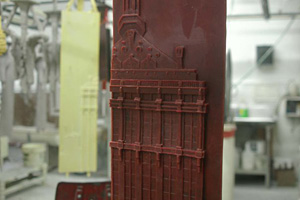 The Lost Wax casting process at work.
The Lost Wax casting process at work.Photographs Courtesy of Excalibur Bronze
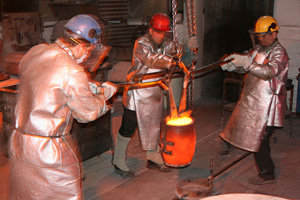 Pouring the bronze
Pouring the bronzeToday, Excalibur has grow to include an impressive portfolio, casting notable sculptures and architectural renovations around the country, including New York City’s Grand Central Station, The Helmsley Building and The New York Public Library to name a few.
The business employs 12 to 14 highly skilled designers, mold-makers, metalworkers, patination masters, craftspeople and engineers with years of combined experience. Three major divisions encompass complete design and engineering services for sculptures, statues and monuments, restorations and the Excalibur Collection. All production is done at the Brooklyn facility which includes exhibition and gallery space that can accommodate a crowd.
William's son, Joshua Gold, grew up around the foundry and shares his father's passion for bronze creations. A graduate of Brooklyn Law School, he recently left his career as an attorney to become Excalibur's Vice President and pursue his love for making things. He acquired his expertise casting bronze sculpture and participating in numerous restorative projects from working alongside his father.
"It takes a long time to develop rapport with metal,” says Joshua. “While I do things much like my father does, there are a few generational differences. He uses a hand-drawn, traditional approach and I often utilize computer generated design techniques. When designers come to us, that's great because they know exactly what they want. Others ask us to construct originals and that is also good because it calls upon our creativity."
Lost wax casting, which originated in India circa 3500 BC, is Excalibur's preferred process because it is extremely versatile and can be used for casting bronze projects too complicated for other methods. A sculpture/model is created or duplicated in wax.
During the reconstruction of a 32-story Art Deco building's intricate facade destroyed on 9/11 when the towers next door collapsed, the Excalibur field crew made wax molds at the site with the help of historic photographs and brought the models to the foundry.
An outer shell is formed around the model and a liquid rubber compound is poured. When it hardens, the mold is separated along predetermined seams, the model extracted and filled with molten hard wax painted into the interior for casting. The ceramic shell is subjected to a 4' x 3' drop gas furnace for calcining. Wax is dipped into a liquid ceramic slurry adding a fine powder to pick up details and textures on the first dip.
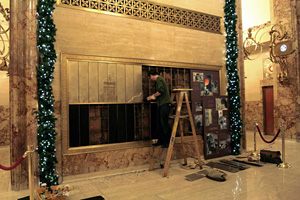 Installing a pair of custom bronze wall sculptures at the Hemsley Building in New York City last December.
Installing a pair of custom bronze wall sculptures at the Hemsley Building in New York City last December.Photographs courtesy of Excalibur Bronze
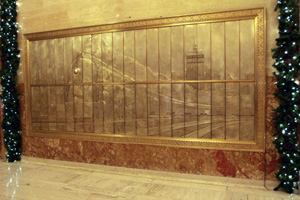 The finished installation was unveiled January 11, 2010.
The finished installation was unveiled January 11, 2010.When the first coat dries in about 24 hours, several coats of coarser material are added to increase the shell's strength. The shell goes back into the furnace and is baked at 2000 degrees and the wax inside melts—hence the name, lost wax--creating a hollow ceramic mold.
Excalibur professionals then melt ingots or recycled bronze in a crucible using an electric induction furnace and pour the molten bronze. After the casting cools, the shell is broken and fragments are removed by sandblasting.
Very large models that can't be cast as one may require welding together of workable size sections. Heated metal tools rub out marks or flashing where pieces join. Pits from air bubbles are filed down and polished while sanding and welding fix imperfections in the metal.
Finally, the experts at Excalibur apply hot and cold patinas, along with chemicals such as acid, to oxidize or react with the metal surface for various colors and effects. The patina gets waxed and buffed to protect the finish.
Joan Benefiel, born and raised in Wichita, studied art at the University of Kansas, then developed her skills working as assistant to a sculptor in Kansas City. Her desire to produce large-scale public art and figurative sculptures inspired her work with bronze. As a technician at a local foundry, she learned the lost wax method of casting before relocating to New York where she joined the Excalibur team. She describes them as "a truly unique and versatile group of talented artists, craftspeople and designers."
Benefiel's penchant for creating large-scale public works was satisfied on a recent project she created with two architect friends, Shannon Diamondstein and Hui Min Chan.
“I answered Nassau County Vietnam Veteran's Monument Committee's call for monument submissions and received unanimous approval,” says Benefiel. “We designed the site, base and sculpture. Excalibur enlarged my small model up to 12 feet tall and cast it in bronze. It was installed and unveiled at Eisenhower State Park in November, 2005."
The monument depicts brotherhood and features two clasped hands bound together by a chain with dog tags that swing and chime in the wind.
Excalibur's handiwork can be seen throughout New York City. On the walkway beneath the Brooklyn Bridge's two towers, they constructed bronze bas-relief panels that identify landmarks in lower Manhattan and Brooklyn.
At the New York Public Library, Excalibur restored sixty baluster-shaped bronze based lamps and created 100 more originals in the main reading room. Insides of the brass shades were painted white for maximum lighting, missing rosettes were recreated on 18 chandeliers and lion-shaped bronze fixtures were made for the entryway to the main reading room.
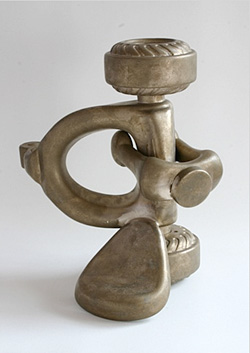 Deconstructed Tric, bronze, sculpted by Tyrome Tripoli and cast by Excalibur Bronze.
Deconstructed Tric, bronze, sculpted by Tyrome Tripoli and cast by Excalibur Bronze.Photograph Courtesy of Excalibur Bronze
During the historic restoration at Grand Central Station, Excalibur designed, sculpted, cast and fabricated decorative grillwork and 24 new ticket windows to replicate the originals.
Created from motifs, Excalibur also sculpted and cast the white bronze marquee over the Park Avenue entrance to the Waldorf-Astoria and created decorative elements like 14' high grills and 7' tall light urns in the main lobby. They also designed, fabricated, cast, finished and installed the decorative bronze railings at the Plaza Hotel.
Recently, when the management of the Helmsley Building on Park Avenue wanted an original centerpiece in the main lobby that would recall the building's origins as headquarters of New York Central Railroad, they chose Excalibur. The foundry hired Benefiel to sculpt two large-scale reliefs based on a painting of two trains in front of a 1920's New York City skyline. They then cast and installed the bronze murals which were unveiled on January 11, 2010 after receiving New York City Landmarks Preservation Commission's approval.
In May of 2010, the first Candlelight Bronze Pour was held. Donning fire retardant suits and full foundry gear such as safety helmets and goggles, Excalibur artisans carried a red-hot graphite crucible of 2,000-degree molten bronze to molds sitting on a sand pit container. Suspended by chain from a crane, the crucible was then poured into the molds to cool.Several hundred people attended the exhibition.
"New York has such a vibrant and interesting art community,” Says Joshua. “We like to get to know people and have them get to know us. These demonstrations give us an opportunity to do that."
The Excalibur Collection also consists of decorative and functional bronze furniture such as tables, sconces, chandeliers, desks, hurricane lamps with brass bases, various lighting and accessories. In the past, delicate metal frames and fanciful brass animals employed by other furniture makers served as inspiration. New, completely original pieces are now being created and produced by William and Joshua Gold. Joshua Gold describes their current designs as "unique and eclectic, with no rehash." Some will include stained glass and colored lights.
The father/son collaboration plans on exhibiting this fall at an opening event that will be accompanied by a second Candlelight Bronze Pour. Plans are also underway to begin offering a sculpture foundry education program in 2011.
Resources:
Also in this Issue:
- Excalibur Bronze Sculpture Foundry: Using a 6,000 Year Old Method in Today’s World
- Make Your Dog Smile: Custom Copper Pet Tags Made with Love
- Purpose and Re-Purpose: The Reclaimed Copper Art of Shaw Lakey
- Julie Joy Saypoff: Communicating The Energy of Emotion Through Copper
- Bronze Sculptor Ken Newman Chosen for Top North American Juried Art Exhibitions
